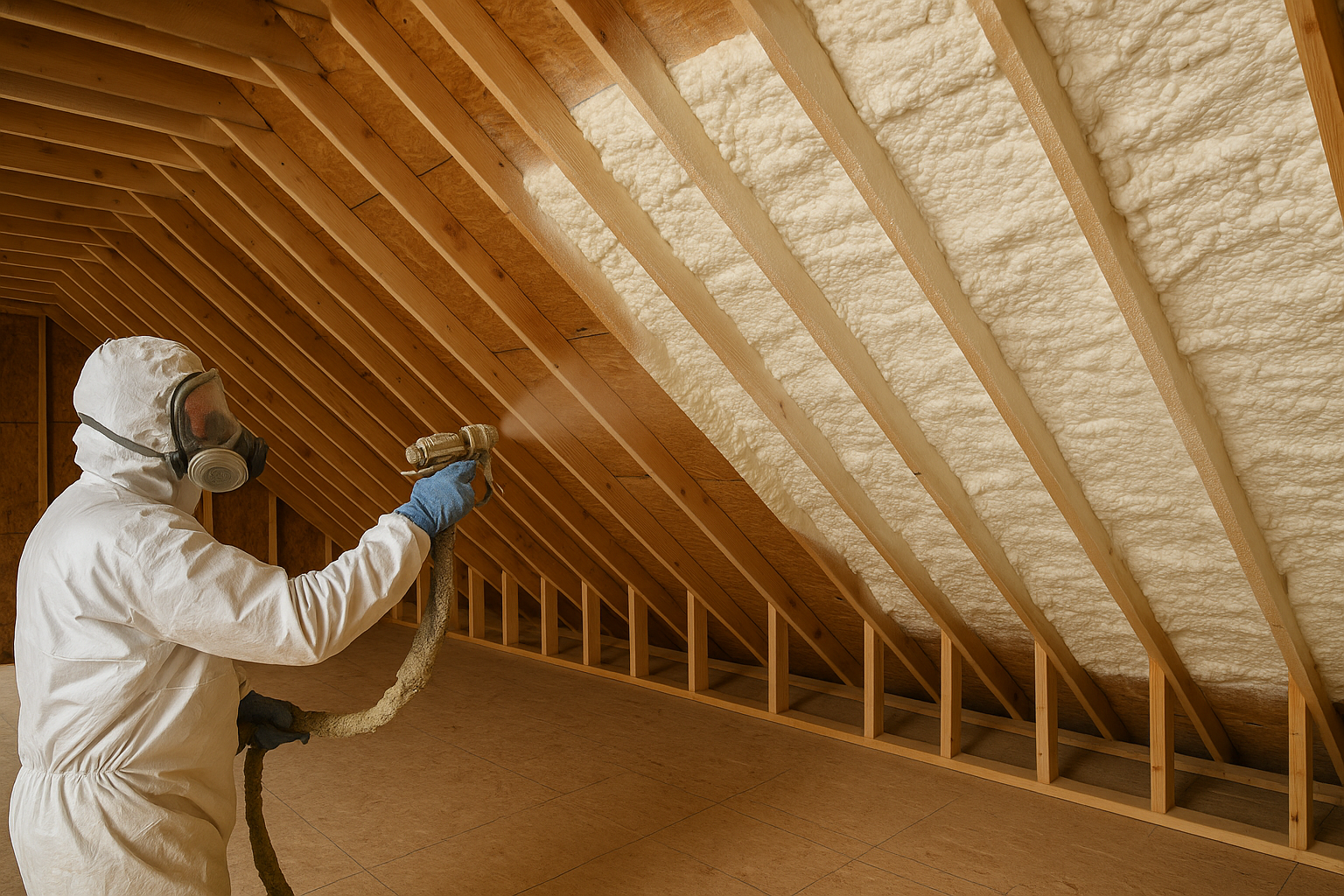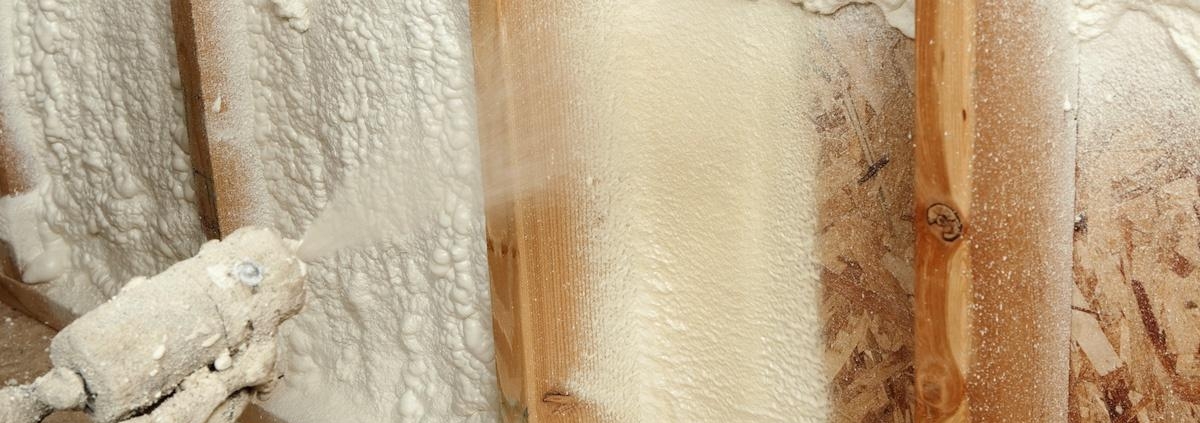A Complete Breakdown of R-Values for Spray Foam Insulation
A complete breakdown of R-values for spray foam insulation begins with a clear understanding of what R-value actually is: a measurement of a material’s ability to resist the flow of heat. For any insulation, a higher R-value means better thermal performance. With spray foam, however, the R-value is only half of the story. Its true effectiveness comes from the combination of this thermal resistance with its unique ability to create a near-perfect air seal. This dual-action performance is what makes it such a powerful tool for creating a comfortable and energy-efficient home.
To make the best choice for a specific project, it’s helpful to understand the R-values for the two main types of professional spray foam insulation and what those numbers mean in the real world. The following information comes directly from the practical, hands-on experience of certified insulation professionals who work with these materials every day.
What is R-Value and Why Does It Matter?
R-value is the industry standard for rating an insulation material’s ability to resist conductive and convective heat transfer. In the winter, a high R-value insulation is very effective at keeping the warm, heated air inside your home. In the summer, it does the reverse, providing a powerful barrier against the intense heat of the sun. This resistance to heat flow is the primary job of any insulation, and it is the key to both home comfort and energy efficiency.
More Than Just a Number
It is important to understand that the stated R-value of a product is a lab-tested measurement. The real-world, or “effective,” R-value of an insulation system can be much lower if it is not installed correctly. This is especially true for traditional insulation materials like fiberglass batts. If there are gaps, voids, or compressed spots in the installation, heat can bypass the insulation, significantly reducing its performance. Because spray foam expands to fill every crack and crevice, it creates a seamless, gap-free installation, which ensures that its effective R-value is as close as possible to its lab-tested potential.
The Two Main Types of Spray Foam and Their R-Values
Spray foam insulation comes in two primary forms, open-cell and closed-cell, and their different physical structures give them very different R-values and performance characteristics.

Open-Cell Spray Foam
Open-cell spray foam has a soft, flexible, and spongy texture because its cells are not completely sealed. This structure makes it an exceptional air barrier and an excellent sound-dampening material. Because its cells are filled with air, it has a lower R-value than its denser counterpart.
- Typical R-Value: Approximately R-3.5 to R-3.7 per inch of thickness.
Closed-Cell Spray Foam
Closed-cell spray foam has a dense, rigid structure made of tiny, completely sealed cells. These cells are filled with a specialized “blowing agent,” which is a gas that is a much better insulator than air. This is what gives closed-cell foam its very high thermal resistance. This structure also makes the foam waterproof and impermeable to water vapor, so it can act as a built-in vapor barrier.
- Typical R-Value: Approximately R-6.0 to R-7.0 per inch of thickness.
Here is a look at how the R-values of spray foam compare to other common insulation materials:
| Insulation Type | Typical R-Value per Inch | Key Performance Characteristics |
|---|---|---|
| Closed-Cell Spray Foam | R-6.0 – R-7.0 | Highest R-value; also an air and vapor barrier. Adds structural strength. |
| Open-Cell Spray Foam | R-3.5 – R-3.7 | Excellent air barrier and sound absorber. Remains flexible. |
| Fiberglass Batts | R-2.9 – R-3.8 | Standard thermal insulator; does not stop air leakage. Performance is highly dependent on installation quality. |
| Blown-in Cellulose | R-3.2 – R-3.8 | Fills cavities well but can settle over time; does not provide an air seal. |
| Rigid Foam Board | R-4.0 – R-5.5 | Good thermal barrier but has seams that must be meticulously sealed to be effective. |

How Climate and Building Codes Determine R-Value Requirements
While these numbers provide a useful comparison, the right R-value for a home is not a universal number; it changes based on your geographic location. The U.S. Department of Energy has divided the country into climate zones, and building codes in each zone specify the minimum R-values required for attics, walls, and floors.
For example, a home in a cold climate like the Northeast will require a much higher R-value in its attic (often R-49 or higher) than a home in a hot climate like North Carolina (R-38 is common). A professional insulation contractor will be an expert in the specific code requirements for their local area.
Bonus Tip: In a mixed-humid climate like that found in the Raleigh area, one of the most effective energy-saving strategies is to apply closed-cell spray foam directly to the underside of the roof deck. This creates a “conditioned” or “unvented” attic, which stops the attic from becoming a super-heated oven in the summer and prevents the moisture issues that can arise in the winter.
Things to Consider When Choosing Your Insulation
- Your Primary Goal: What is the most important problem you are trying to solve? If it is to achieve the absolute highest R-value in a limited space, like a 2×4 wall, the high R-value of closed-cell foam is the clear choice. If you are focused on creating sound privacy between rooms, the superior sound-dampening quality of open-cell foam might be the better fit.
- Budget: Closed-cell foam is a premium product with a higher upfront cost. However, its superior performance, durability, and all-in-one nature can often provide a faster return on investment through greater energy savings and by preventing costly moisture-related repairs.
- The Quality of the Installation: The performance of any insulation material is only as good as its installation. This is especially true for spray foam, which is a chemical product manufactured on-site. It is absolutely essential to hire a certified, experienced contractor with modern, well-maintained equipment to ensure the foam is applied correctly and performs as expected.
Bonus Tip: A professional home energy audit can be a great investment before you upgrade your insulation. An auditor can use tools like a blower door test and an infrared camera to identify the biggest sources of energy loss in your home, allowing you to target your investment where it will have the most impact.
Common Questions About R-Value and Performance
Does the R-value of spray foam diminish over time?
No. Once cured, spray foam is a highly stable plastic that does not settle, sag, or degrade. The R-value it provides on day one is the R-value it will provide for the life of the building.
Can you get any total R-value you want?
Yes, because R-value is cumulative. A professional installer can apply the foam in layers to achieve any desired thickness and total R-value. For example, 6 inches of a closed-cell foam with an R-value of 6.5 per inch would result in a total of R-39.
Why is the air seal so important to the R-value?
Even a wall with a high R-value insulation will not perform well if it is leaky. Air leakage allows heat to bypass the insulation, completely negating its effectiveness. By stopping the air leakage, spray foam ensures that the insulation can perform at its maximum potential.
Final Thoughts on Insulation Performance
A solid understanding of R-values is the foundation for making a smart decision about your home’s energy efficiency. However, it is important to look beyond the number on the label and consider the real-world performance of the entire insulation system. By combining a high thermal resistance with a complete and permanent air seal, spray foam insulation contractor offers a level of performance that can truly transform how a home feels and how much it costs to heat and cool.
Get a Professional Insulation Plan for Your Home
To determine the right R-value and the most effective insulation strategy for your property, the best first step is a professional assessment. An experienced insulation contractor can evaluate your home’s specific needs and design a system that will deliver optimal comfort and energy savings. For homeowners in the Raleigh area looking for an expert consultation, the team at Raleigh Excel Spray Foam Insulation offers comprehensive evaluations. They can be reached by email at info@raleighexcelsprayfoam.com or by phone at (919) 301-9435.
Editorial Note: This post was reviewed for technical accuracy by William Harris, an industry expert with nearly a decade of experience in the spray foam insulation field. His guidance ensures the information reflects both technical understanding and real-world application.
Reviewer: With nearly a decade in the spray foam insulation field, William Harris reviewed this post and provided guidance that reflects both technical understanding and real-world marketing experience.



Leave a Reply
Want to join the discussion?Feel free to contribute!